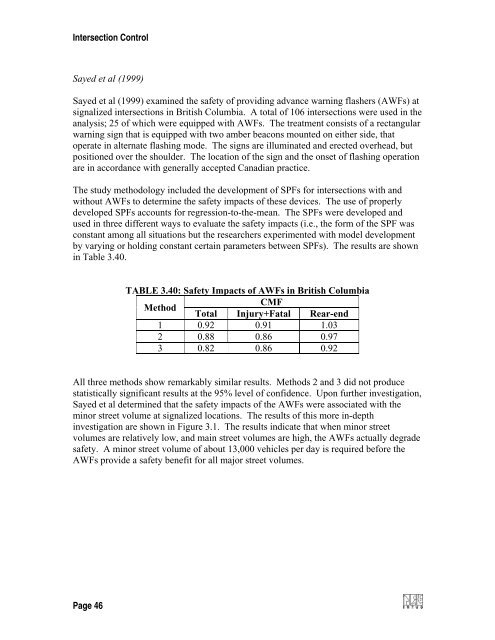Synthesis of Safety for Traffic Operations - Transports Canada
Synthesis of Safety for Traffic Operations - Transports Canada
Synthesis of Safety for Traffic Operations - Transports Canada
Create successful ePaper yourself
Turn your PDF publications into a flip-book with our unique Google optimized e-Paper software.
Intersection Control<br />
Sayed et al (1999)<br />
Sayed et al (1999) examined the safety <strong>of</strong> providing advance warning flashers (AWFs) at<br />
signalized intersections in British Columbia. A total <strong>of</strong> 106 intersections were used in the<br />
analysis; 25 <strong>of</strong> which were equipped with AWFs. The treatment consists <strong>of</strong> a rectangular<br />
warning sign that is equipped with two amber beacons mounted on either side, that<br />
operate in alternate flashing mode. The signs are illuminated and erected overhead, but<br />
positioned over the shoulder. The location <strong>of</strong> the sign and the onset <strong>of</strong> flashing operation<br />
are in accordance with generally accepted Canadian practice.<br />
The study methodology included the development <strong>of</strong> SPFs <strong>for</strong> intersections with and<br />
without AWFs to determine the safety impacts <strong>of</strong> these devices. The use <strong>of</strong> properly<br />
developed SPFs accounts <strong>for</strong> regression-to-the-mean. The SPFs were developed and<br />
used in three different ways to evaluate the safety impacts (i.e., the <strong>for</strong>m <strong>of</strong> the SPF was<br />
constant among all situations but the researchers experimented with model development<br />
by varying or holding constant certain parameters between SPFs). The results are shown<br />
in Table 3.40.<br />
TABLE 3.40: <strong>Safety</strong> Impacts <strong>of</strong> AWFs in British Columbia<br />
Method<br />
CMF<br />
Total Injury+Fatal Rear-end<br />
1 0.92 0.91 1.03<br />
2 0.88 0.86 0.97<br />
3 0.82 0.86 0.92<br />
All three methods show remarkably similar results. Methods 2 and 3 did not produce<br />
statistically significant results at the 95% level <strong>of</strong> confidence. Upon further investigation,<br />
Sayed et al determined that the safety impacts <strong>of</strong> the AWFs were associated with the<br />
minor street volume at signalized locations. The results <strong>of</strong> this more in-depth<br />
investigation are shown in Figure 3.1. The results indicate that when minor street<br />
volumes are relatively low, and main street volumes are high, the AWFs actually degrade<br />
safety. A minor street volume <strong>of</strong> about 13,000 vehicles per day is required be<strong>for</strong>e the<br />
AWFs provide a safety benefit <strong>for</strong> all major street volumes.<br />
Page 46
















